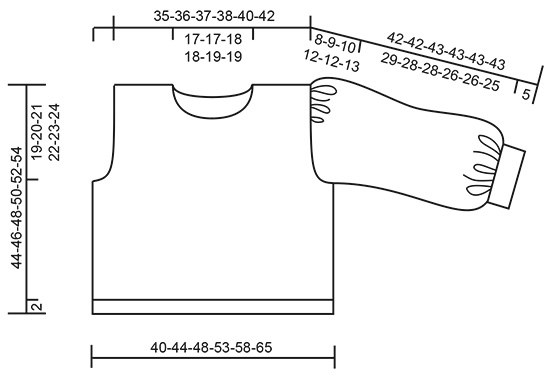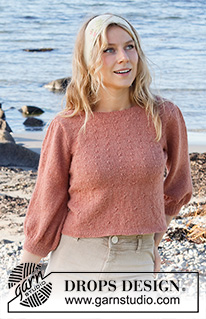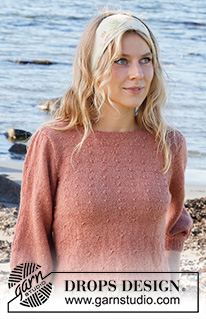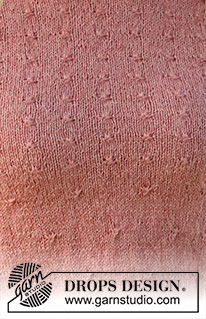Copper Harbor Sweater |
|||||||
 |
 |
||||||
Knitted sweater in DROPS Alpaca. The piece is worked with knotted pattern and ¾-length balloon sleeves. Sizes S - XXXL.
DROPS 221-39 |
|||||||
|
------------------------------------------------------- EXPLANATIONS FOR THE PATTERN: ------------------------------------------------------- MOSS STITCH: ROUND 1: * Knit 1, purl 1 *, work from *-*. ROUND 2: Knit over purl and purl over knit. Repeat round 2. PATTERN: See diagrams A.1 and A.2. The diagrams show all rows in the pattern from the right side. DECREASE TIP (for sleeves): Decrease 1 stitch on either side of the marker thread as follows: Work until there are 3 stitches left before the marker thread, knit 2 together, knit 2 (marker thread sits between these 2 stitches), slip 1 stitch as if to knit, knit 1 and pass the slipped stitch over the knitted stitch (2 stitches decreased). INCREASE TIP (evenly spaced): To work out how to increase evenly, count the total number of stitches on the needle (e.g. 80 stitches) and divide by the number of increases to be made (e.g. 16) = 5. In this example, increase by making 1 yarn over after each 5th stitch. On the next round knit the yarn overs twisted to avoid holes. ------------------------------------------------------- START THE PIECE HERE: ------------------------------------------------------- SWEATER – SHORT OVERVIEW OF THE PIECE: The body is worked in the round with circular needle as far as the armholes. The front and back pieces are then finished separately, back and forth on the needle. The sleeves are worked in the round with double pointed needles/short circular needle, bottom up. The sleeve cap is worked back and forth to finish. The shoulder seams are sewn together and the sleeves are sewn in. A neck is worked in moss stitch to finish. BODY: Cast on 195-211-231-255-279-311 stitches with circular needle size 2.5 MM = US 1.5 and Alpaca. Work MOSS STITCH in the round for 2 cm = ¾" – read description above. Change to circular needle size 3 MM = US 2.5. Work 2 rounds of stockinette stitch and decrease 1 stitch on the first round = 194-210-230-254-278-310 stitches. Insert 1 marker thread at the beginning of the round and 1 marker thread after 97-105-115-127-139-155 stitches (= sides of body). Allow the threads to follow you work onwards. The next round is worked as follows: 6-2-7-5-3-3 stitches in stockinette stitch, work A.1A (= 12 stitches), A.1B over the next 64-80-80-96-112-128 stitches (= 4-5-5-6-7-8 repeats of 16 stitches), A.1C (= 9 stitches), 12-4-14-10-6-6 stitches in stockinette stitch (marker thread sits in the middle of these stitches), work A.1A (= 12 stitches), A.1B over the next 64-80-80-96-112-128 stitches (= 4-5-5-6-7-8 repeats of 16 stitches), A.1C (= 9 stitches) and finish with 6-2-7-5-3-3 stitches in stockinette stitch. Continue this pattern. REMEMBER THE KNITTING GAUGE! When A.1 has been worked 2 times in height, the piece measures approx. 20 cm = 8" from the cast-on edge. The next round is worked as follows: 6-2-7-5-3-3 stitches in stockinette stitch, work A.2A (= 4 stitches), A.2B over the next 72-88-88-104-120-136 stitches (= 9-11-11-13-15-17 repeats of 8 stitches), A.2C (= 9 stitches), 12-4-14-10-6-6 stitches in stockinette stitch (marker thread sits in the middle of these stitches), work A.2A (= 4 stitches), A.2B over the next 72-88-88-104-120-136 stitches (= 9-11-11-13-15-17 repeats of 8 stitches), A.2C (= 9 stitches) and finish with 6-2-7-5-3-3 stitches in stockinette stitch. Continue this pattern – A.2 is repeated in height to finished length. AT THE SAME TIME when the piece measures 25-26-27-28-29-30 cm = 9¾"-10¼"-10⅝"-11"-11⅜"-11¾", bind off for the armholes on the next round as follows – make sure this in an odd round in A.2 (this is important to avoid working knots from the wrong side when the front and back pieces are continued back and forth): Start 3 stitches before the marker thread at the beginning of the round and bind off 6 stitches for the armhole, work 91-99-109-121-133-149 stitches as before (= front piece), bind off 6 stitches for the armhole and work the last 91-99-109-121-133-149 stitches as before (= back piece). The front and back pieces are finished separately. BACK PIECE: = 91-99-109-121-133-149 stitches. Continue the pattern back and forth (start from the wrong side), and bind off for the armholes at the beginning of each row on both sides as follows: 3 stitches 0-0-0-1-2-2 times, 2 stitches 1-2-3-4-4-6 time and 1 stitch 1-2-4-4-4-6 times on each side = 85-87-89-91-97-101 stitches. NOTE: The stitches which are not enough to make a knot on each side are worked in stockinette stitch. Continue working until the piece measures 42-44-46-48-50-52 cm = 16½"-17¼"-18"-19"-19¾"-20½". On the next row bind off the middle 37-37-39-39-41-41 stitches for the neck and each shoulder is finished separately. Continue the pattern and bind off 2 stitches on the next row from the neck = 22-23-23-24-26-28 stitches. Work until the piece measures 44-46-48-50-52-54 cm = 17¼"-18"-19"-19¾"-20½"-21¼" from the shoulder down. Bind off. Work the other shoulder in the same way. FRONT PIECE: = 91-99-109-121-133-149 stitches. Continue the pattern back and forth (start from the wrong side), and bind off for the armholes at the beginning of each row on both sides as follows: 3 stitches 0-0-0-1-2-2 times, 2 stitches 1-2-3-4-4-6 times and 1 stitch 1-2-4-4-4-6 times = 85-87-89-91-97-101 stitches. Continue working until the piece measures 36-38-39-41-42-44 cm = 14¼"-15"-15¼"-16⅛"-16½"-17¼". On the next row place the middle 19-19-21-21-23-23 stitches on 1 thread for the neck and each shoulder is finished separately. Continue the pattern and bind off on each row from the neck as follows: 3 stitches 1 time, 2 stitches 2 times and 1 stitch 4 times = 22-23-23-24-26-28 stitches on the shoulder. Work until the piece measures 44-46-48-50-52-54 cm = 17¼"-18"-19"-19¾"-20½"-21¼" from the shoulder down. Bind off. Work the other shoulder in the same way. SLEEVE: Cast on 57-61-65-69-73-77 stitches with double pointed needles size 2.5 MM = US 1.5 and Alpaca. Work moss stitch in the round for 5 cm = 2". Knit 1 round where you knit 1 stitch in both the front and back loops of all stitches (doubles the number of stitches) = 114-122-130-138-146-154 stitches. Change to short circular needle size 3 MM = US 2.5 and insert 1 marker thread at the beginning of the round = mid under sleeve. Allow the thread to follow your work onwards; it is used when decreasing under the sleeve. Work stockinette stitch in the round. When the sleeve measures 6 cm = 2⅜" in all sizes, decrease 2 stitches under the sleeve – read DECREASE TIP. Decrease like this every 4th-4th-4th-3rd-3rd-3rd round a total of 17-19-20-21-21-22 times = 80-84-90-96-104-110 stitches. AT THE SAME TIME when the sleeve measures 25-24-24-23-23-22 cm = 9¾"-9½"-9½"-9"-9"-8¾", increase 16-16-18-18-20-20 stitches evenly on the round – read INCREASE TIP. After all the decreases and increases there are 96-100-108-114-124-130 stitches. When the sleeve measures 34-33-33-31-31-30 cm = 13⅜"-13"-13"-12¼"-12¼"-11¾", work the next round as follows: Start 3 stitches before the marker thread, bind off 6 stitches and knit to end of the round. Now work the sleeve cap back and forth with circular needle as follows. Work stockinette stitch and bind off at the beginning of each row on each side as follows: 3 stitches 0-0-0-0-1-1 time, 2 stitches 3-4-4-4-4-4 times, 1 stitch 4-4-7-10-9-10 times, 2 stitches 4-4-3-3-3-4 times and then 3 stitches 1-1-1-1-1-1 time on each side = 48-48-54-54-60-60 stitches. The next row is worked as follows from the right side: Work 8-8-9-9-10-10 stitches in stockinette stitch, knit together the next 32-32-36-36-40-40 stitches 2 and 2 (= 16-16-18-18-20-20 stitches decreased) and work 8-8-9-9-10-10 stitches in stockinette stitch = 32-32-36-36-40-40 stitches left. Bind off. The sleeve measures approx. 42-42-43-43-43-43 cm = 16½"-16½"-17"-17"-17"-17". Work the other sleeve in the same way. ASSEMBLY: Sew the shoulder seams and sew in the sleeves, inside the 1 edge stitch. NECK: Start on one shoulder and knit up from the right side 99 to 117 stitches around the neck (including the stitches on the thread in front) with short circular needle size 2.5 MM = US 1.5 and Alpaca. The number of stitches should be divisible by 2 + 1. Work moss stitch in the round for 2 cm = ¾". Bind off with moss stitch. |
|||||||
Diagram explanations |
|||||||
|
|||||||

|
|||||||

|
|||||||
|
Have you made this or any other of our designs? Tag your pictures in social media with #dropsdesign so we can see them! Do you need help with this pattern?You'll find tutorial videos, a Comments/Questions area and more by visiting the pattern on garnstudio.com. © 1982-2024 DROPS Design A/S. We reserve all rights. This document, including all its sub-sections, has copyrights. Read more about what you can do with our patterns at the bottom of each pattern on our site. |
|||||||








































































Comments / Questions (13)
Ich habe unten 2 cm im Perlmuster gestrickt. Jetzt rollt sich das Bündchen. Was kann ich im Nachhinein tun, um dies zu beseitigen?
18.07.2022 - 19:05DROPS Design answered:
Liebe Martina, wenn Sie den Pullover nach dem Fertigstellen anfeuchten und dann liegend trocknen lassen oder die betreffenden Stellen unter ein feuchtes Handtuch legen und das dann trocknen lassen, sollte sich nichts mehr rollen.
28.07.2022 - 08:03Hei, jeg lurer på når man lager knutene, så slippes jo tre masker ut, hvordan skal disse erstattes? Det står ingen forklaring på det…..
13.03.2022 - 15:31DROPS Design answered:
Hej, Du strikker de samme 3 masker sammen ialt 3 gange, til du har 3 nye masker på højre pind, nu kan du slippe dem af venstre pind :)
15.03.2022 - 15:25Hej, Jeg er igang med en M og er ved semi starten. Er ved ryg og forstykket. Jeg har strikket A1- 2 gange og det måler kun 9 cm. Skal jeg forsætte A1 til det måler 20 cm?
07.08.2021 - 22:46DROPS Design answered:
Hej Maja. A.1 består av 28 p, och den ska stickas 2 gånger (=56 p totalt) så om du har riktig strikkefasthet så bör arbetet måle ca 20 cm.. Är du säker på att din strikkefasthet är riktig? Mvh DROPS Design
17.08.2021 - 14:26Hi. Can you explain this section again so I can understand? "On the next row place the middle 19-19-21-21-23-23 stitches on 1 thread for the neck and each shoulder is finished separately. Continue the pattern and cast off on each row from the neck as follows: 3 stitches 1 time, 2 stitches 2 times and 1 stitch 4 times = 22-23-23-24-26-28 stitches on the shoulder."
06.07.2021 - 05:05DROPS Design answered:
Dear Anna, put the middle stitches on a spare needle, stitch holder, or a piece of thread, then continue with one shoulder. On every other row (the rows that are knitted AWAY from the neck) ast off further 3 stitches once, , 2 stitches twice and then 1 stitch in every 2nd row, 4 times = you will have 22-23-23-24-26 stitches on the shoulder. Happy stitching!
06.07.2021 - 07:16Me está costando un poco entender el patrón. El remate para el escote es 3 puntos 1 vez, 2 puntos 2 veces y 1 punto 4 veces, no queda el cuello bien, queda demasiado estrecho y nada redondeado. ¿qué puedo hacer?
10.04.2021 - 19:34DROPS Design answered:
Hola Esperanza, las disminuciones para el escote están correctas, lo único tienes que asegurarte de cerrar los puntos flojo. Si esto no soluciona tu problema, lo mejor sería contactar con tu tienda DROPS más cercana, para que pueda ofrecerte ayuda más personalizada.
11.04.2021 - 20:44Peaches & Cream
17.01.2021 - 22:35Golden Hour
17.01.2021 - 22:27Marmelade Dreams
17.01.2021 - 22:27"Morning Blush"
08.01.2021 - 14:15Poppy barley
07.01.2021 - 23:01